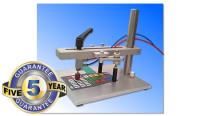 Add My Company
Add My Company
Sign In

The B886 Simon System has been designed for life cycle and fatigue testing of switches, membrane switches, keyboards and keypads. It system contains all the components needed to life and fatigue test a wide range of components (Control Unit, test fixture, power supply, pneumatic cylinder & Hoses, silicone test probe, USB lead, Windows software and instruction manual).
How easy is it to use?
Simply decide on the force required, enter the resistance values, the number of cycles and product name then push start. There are lots of other things that you can set or adjust but for many tests the default values that Banair have already entered for you will be fine. When the test is completed the results will be stored in an Access database and you can print out a test certificate.
Now, simply put the product in the jig and place the probe over the switch to be tested.
How long will the test take?
The typical membrane specification calls for 1 million operations. If you set the system for 4 cycles per second then this would take just under 3 days.(4 cycles x 60 seconds x 60 minutes x 24 hours x 3 days = 1,036,800 cycles) You may need to adjust the cycle time depending on your requirements. The test time for 1 C/S would be just under 12 days. (Testing Specification ASTM F1578-01, ASTM F1578-07, ASTM F1578-96)
What else do I need to get started?
1. A PC or laptop running Windows and a free USB socket. Microsoft Office will help you analyse and print your results but you can perform standard tests without this.
2. An air supply (Max 6 bar).
3. A product to test.
Everything else is included for you to start testing straight away.
Why is it called "Simon"?
We like to give our equipment names as you might have noticed, why do we do this, well, as you will find out, they will soon become part of your team, just like a new work colleague.
Features
Bullet point
Adjustable force between 200g and 3500g
Bullet point
Vary speed up to 10 cycles per second depending on configuration
Bullet point
Measure switch resistance each cycle 1 to 10,000 Ohms
Bullet point
Measure switch bounce in mS
Bullet point
Log results to an Access database
Bullet point
Print a certificate in your own format, using a Word template
Bullet point
Stop on failure or choose to continue with a warning screen
Bullet point
Pause at any time to check physical condition of switch, then resume. Simon will still remember your results
Bullet point
Display activation's per hour
Bullet point
Display the total time elapsed, adjusted for pause time
Bullet point
Save part number, serial number and customer details to a database and a certificate
Bullet point
Display the change in contact resistance
Bullet point
Adjustable test current
Bullet point
Adjustable probe height 0 to 150 mm
Bullet point
Adjustable probe position 0 to 120 mm range
Bullet point
Fully adjustable membrane position using two retractable clamps
Bullet point
Standard rubber probe 15 mm diameter
Switch Bounce Testing
Nearly all switches will generate some "bounce" when they are operated (switched). Every time they are operated, they will actually open and close their contacts several times before they settling down to their new position. For normal switches, this can last from as little as a fraction of a millisecond (ms), to as long as several milliseconds. Only very high quality switches generate little or no bounce. This switch bounce is not usually a problem if you are merely turning on something simple like a light, but if you are working with more sensitive things like logic devices, all these extra bounces can create havoc. An example of a problem would be that if every time you pressed a button to increment a counter you actually added several counts to the total.
For more information on New Model "Simon" Life Cycle Tester - Operate up to 8 cylinders at once! talk to Banair Electronic Engineers
Enquire Now
List your company on FindTheNeedle.
